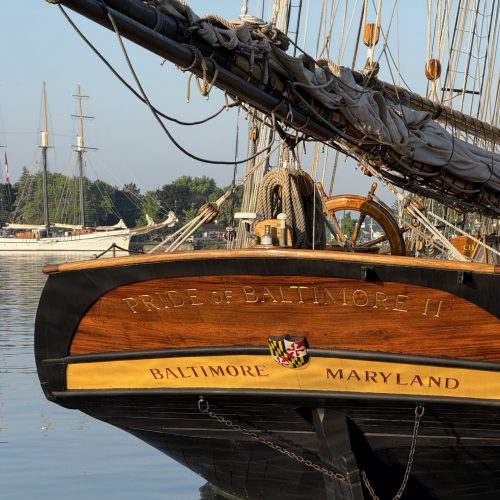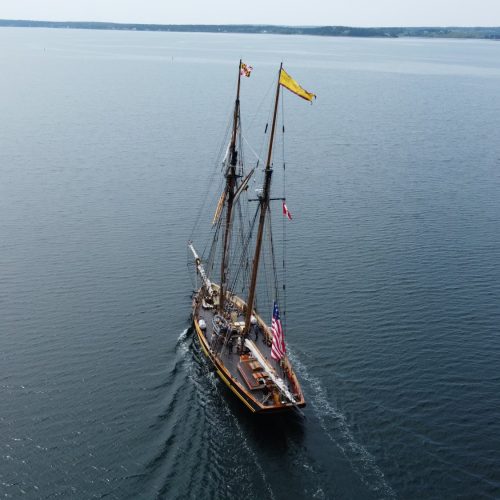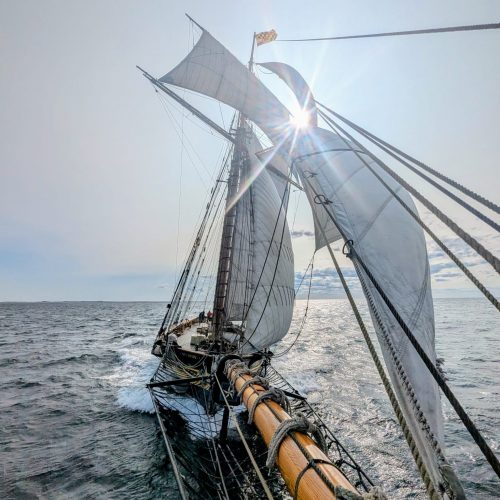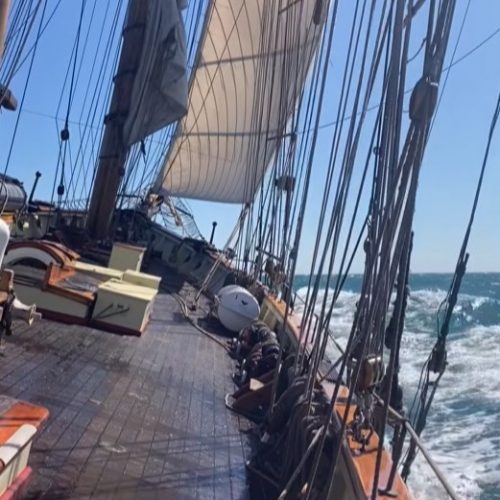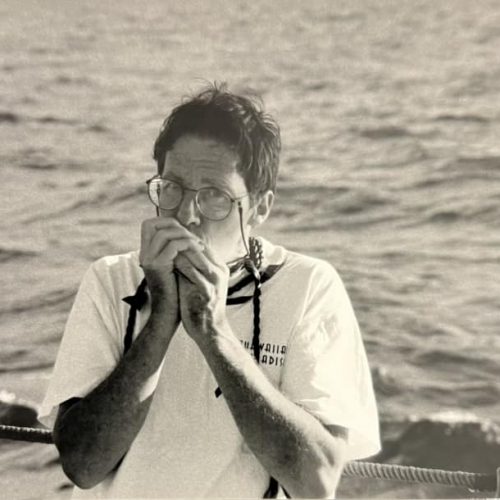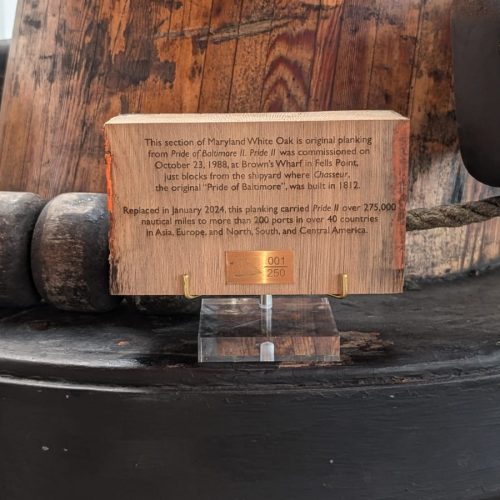Tuesday, 7 August, 2012 / Pride of Baltimore II
Pos: At Anchor off Portland, Maine’s East End / Wx: SE F 3, 3/8 Ci, Pleasant
With scarcely 24 hours at the dock, Pride of Baltimore II was back from her Nova Scotian foray, cleared into U.S. Customs and off on a five-day cruise along the Maine Coast. With no particular destination and the only directive being to sail, we approached the trip in the storied local tradition of “Windjamming.” Originally referring to the last all-sail cargo ships of the early 19th Century, the term now applies to the fleet of vessels in the Penobscot Bay region of Maine which carry passengers on scenic adventures to spectacularly beautiful places. Largely unequipped with engines, the schooners on these trips typically sail through the day and find a quiet anchorage for the night.
And so, for this trip, would Pride II, though in Maryland and other parts south, this practice is also called, “gunkholing.” Admittedly a horribly unattractive term for anchoring in serene and tranquil places, it is descriptive – a good, solidly protected anchorage is often referred to as a hole (as in hiding hole, swimming hole, hurricane hole) and the best holding ground known to sailors is thick, oozy mud, or “gunk.”
Maine being, well, Maine, our cruise got off to a slow start with Portland Harbor socked in fog. But by early afternoon, we could see some of the alleged 365 “Calendar Islands” of Casco Bay and got underway. Setting sail in front of downtown Portland for increased visibility, we were accompanied out of the harbor by the classic Alden schooner Wendameen. Owned and operated as a day-sailer by Portland Schooner Company, Wendameen is a fine sailing yacht-style vessel and one of my commands previous to Pride II. In the hands of Captain Troy Scott, she was besting Pride II in the protected reaches around Peaks, Cushing and House Islands, but her lighter displacement had us break away from her once we reached the exposed channel. We saluted with a single gun; she honked in reply and tacked back in to finish her day sail as we sailed off into a re-thickening fog to anchor between Ministerial and Stave Islands.
A breathless and foggy morning followed our first anchorage, and we motored out of Casco Bay, passing close abeam of Eagle Island, a Maine State Historic Site and formerly the retirement home of Admiral Robert Peary of Polar Exploration Fame. With plans to return later in the week, we carried on toward Penobscot Bay, the foggy conditions giving relevance to a lesson on Deduced Reckoning Navigation until the breeze came up southwesterly and cleared fog. With a downwind run ahead, we impersonated a sloop for the day and set everything but the stuns’l on the foremast, but kept the main and gaff top in their furls, sailing past Monhegan Island and on to anchor in Tenants Harbor.
Saturday, we made Rockland. Ironically, this typical “starting out point” for many of the modern Windjammers, was the farthest afield for us. With good friends and former shipmates around, we were treated to the luxury of a dock at the relatively new “Windjammer” wharf, and nestled in between the schooners Steven Taber and Nathaniel Bowditch. Also sharing this dock was the gorgeous Tancook Whaler Vernon Langille, whose sleek double ended hull, while at home in Penobscot Bay, originated in Mahone Bay, Nova Scotia, between Halifax and Lunenburg.
With a night ashore and a few hours of waiting for the tide, we set off again in, naturally, thick fog, motoring back past Tenants Harbor without ever seeing it, and setting sail just past the horribly named Mosquito Island. Carrying on through fog, the breeze built steadily and soon Pride II was her usual self, skimming along at seven knots. But the breeze was southerly, forecast to build to near gale strength and carry with it a fathom or so of sea. With the toothy rocks of Maine’s coast looming hungry under our lee, every tenth of a knot increase was heartily welcomed. The building breeze scattered the fog, and soon we were up to eight knots. From Monhegan to Seguin Island we carried four lowers and the foretops’l, topping nine knots with regularity, soaking the lee channels, pressing on to make the “corner” and get the wind behind the beam at Seguin.
But it was too much. We wrestled the foretops’l down and walking the deck stopped being a tactical maneuver. But the western horizon sprung up black, and the wind shifted west-southwest, so we brought down the main and jib as well, all hard-fought sail handling as we had no room to fall off and make the job easier. To get us out of the exposed waters, we put engines on line and motor-sailed toward shelter inside Casco Bay. And as if we’d actually sailed through a doorway into another weather world, Pride II was now somehow protected from the whirl and churn beyond the small barriers of Broken Cove, West Brown Cow, and Mink Rocks. Eagle Island lay off to starboard, but our plans of exploration were mere fantasy in this weather.
Sheltered by Great Chebeague Island for the night, we feasted on lobster bought for the crew by volunteer historian Pierre Henkart, then sailed off the hook in moderate and sunny weather for our final day, sailing leisurely through Casco Bay and grandstanding into Portland to end our “Windjammer” cruise Pride II-style – with four guns and flurry of taking in sail.
All best,
Captain Jamie Trost and the Windjamming crew of Pride of Baltimore II

